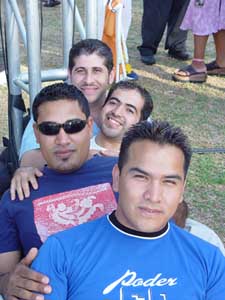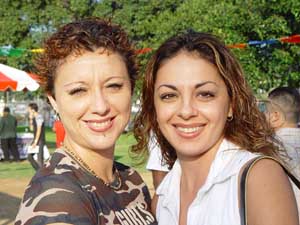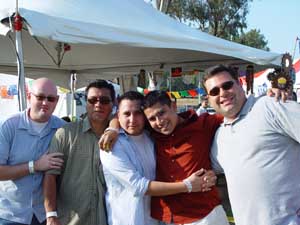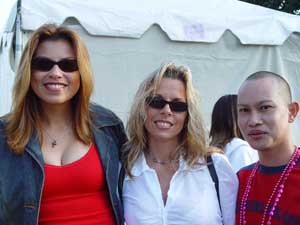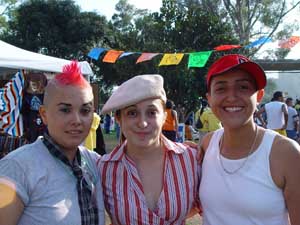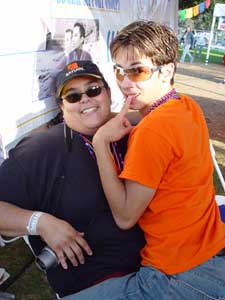-
- Lockyer: State constitution permits laws against same-sex marriage
- Pennsylvania Senate slur prompts apology
- Gay groups want DeMint apology for antigay comments during debate
- Baton Rouge court throws out same-sex marriage ban
- Census data shows many black same-sex couples are raising children
- Bay Area groups seek tolerance for transgender youth
- National News Briefs
- World News Briefs
feature
Pride, with a Latin beat
Published Thursday, 14-Oct-2004 in issue 877
On Saturday, Oct. 16, Balboa Park will be host to another Pride celebration – the fourth annual Latin Pride San Diego Festival. The Festival runs from 12:00 noon to 10:00 p.m., at the intersection of President’s Way and Park Boulevard. In the 2000 census, almost 11 million Californians considered themselves to be of Hispanic or Latino origin. In San Diego, more than 300,000 residents, or 25.4 percent of the population, are Hispanic or Latino according to the same census. So, it’s obvious that Latinos and Latinas are a major and important part of the San Diego community, and it stands to reason that Latinos and Latinas are becoming an ever-more significant part of San Diego’s GLBT community. While these bare facts are unlikely to come as a surprise to anyone immersed in the gay and lesbian scene in San Diego, the growth and presence of this population within the GLBT community is something worthy of its own celebration.
As Ben Gomez, San Diego Latin Pride’s executive director, explains it, Latin Pride isn’t a competitor to Pride; it doesn’t fulfill something lacking in San Diego Pride. While smaller than July’s San Diego Pride, Latin Pride celebrates an important and growing part of San Diego and its GLBT community in particular – the Latina and Latino community. In fact, Gomez credits his nine years working with San Diego Pride and the continued assistance of the staff and planners of San Diego Pride with helping to make Latin Pride happen.
“Without their help and the help of the support staff, I couldn’t do it,” he says. “Thanks to the people at San Diego Pride, I am still learning more about how to plan a festival.”
So, much of what Latin Pride is about is experiencing and celebrating Latin culture in a setting that is welcoming and proud of lesbian and gay lives. Instead of being a replacement for Pride, Latin Pride has two very important and different goals. The first of these is to celebrate the intersection of two minority communities – Latino and GLBT, and the people who live in both at the same time.
“Latino and Latina gays and lesbians are a subculture within a subculture, and Latin Pride is a unique way of celebrating that,” says Gomez.
So, much of what Latin Pride is about is experiencing and celebrating Latin culture in a setting that is welcoming and proud of lesbian and gay lives. In other words, one of the goals of Latin Pride is to be a party where festival-goers, whether Latina/o or not, can enjoy the vast variety of cultural traditions within the broad category of Latino culture. For this reason, according to Gomez, there will be a variety of traditional Mexican food as well as foods from other Caribbean and Central and South American cultures, representing the broad spectrum of Latino culture.
When festival-goers aren’t eating, they can enjoy the lineup of live performances. This year’s Latin Pride celebration plans several types of both traditional and contemporary Latin music styles including salsa, merengue and mariachi, and a number of contemporary DJs. The musical emphasis is on having a good time and getting on the dance floor. “We are having mostly live performances for people to dance,” says Gomez.
Unlike San Diego Pride, which is its own event, Latin Pride is actually a fundraiser for the Bienestar Foundation. In fact, the music at previous Latin Prides has been so popular that one food vendor at this year’s festival asked if they could participate even though they prepare Hawaiian and Pacific Island-style food. “The Islander BBQ wanted to be at the festival just because they love the music so much,” says Gomez.
This not only emphasizes the fun to be had at the festival, it also shows that Latin Pride isn’t just for members of the Latino GLBT community; it is for all members of the larger community with an appreciation for the many faces of Latino culture.
But while having fun and celebrating the Latino GLBT community is one of the goals of Latin Pride, there is another, more serious purpose served by the festival.
“Unlike San Diego Pride, which is its own event, Latin Pride is actually a fundraiser for the Bienestar Foundation”, explains Gomez.
Bienestar (Spanish for “well-being”) was founded in 1989, in Los Angeles, in an effort to address the dearth of adequate HIV/AIDS services to the Latino community. The organization sought to address a perceived neglect of this community by other service organizations and government agencies, because of cultural differences, biases and the language barrier between members of the Latino community and service providers.
Since its foundation, Bienestar has expanded its outreach to the GLBT Latino community and the Latino community at large throughout Los Angeles, San Bernardino and San Diego counties.
In the same period, according to the National Institute of Allergy and Infectious Diseases (NIAID), Latino community and Latino men who have sex with men (MSMs) have been particularly affected. For example, in 1998, although representing only 13 percent of the total population of the United States, Latinos and Latinas accounted for 20 percent of new HIV infections, with Latina women accounting for 19 percent of new infections among women. The year before, in 1997, Latinos and Latinas accounted for almost 19 percent of all AIDS-related deaths, demonstrating that the Latino community has been more severely affected by the AIDS crisis than has the general population, the white and Asian communities or the GLBT community at large. Like the African-American community, the Latino community has borne more than a proportionate share of the crisis. And it is just this problem that Bienestar, together with such other Latino-oriented organizations as CASA-South Bay, Pacto Latin AIDS Organization and Proyecto de Consejo y Apoyo Binacional (PROCABI) on this side of the border and Clinica Acosida A.C., Gay and Lesbian Social Resource Center in Tijuana, have attempted to address through targeted prevention measures, education and assistance with access to treatment for members of the Latino community.
In addition to its continuing efforts to prevent and treat HIV/AIDS, Bienestar has also, according to Gomez, expanded its range of services to include other health and immigration issues pertinent to the GLBT Latino community. Currently, it maintains its emphasis on HIV/AIDS prevention and treatment, while also addressing allied issues such as alcohol and drug abuse and broader questions of pride, self-acceptance and overcoming oppression, as well as basic social services that Latinos and GLBTs have limited access to because of varying degrees of marginalization.
To further these goals, community leaders, including Nicole Murray-Ramirez, Carolina Ramos and Tony Puente, as Gomez recalls, together with representatives of Bienestar, planned the first San Diego Latin Pride for Nov. 11, 2001.
This first festival emulated the wildly popular Los Angeles Latin Pride Festival and Parade, which attracts about 18,000 people a year, and has grown to be a success in San Diego as well.
While San Diego’s Latin Pride is not as large as Los Angeles’, it nonetheless raised over $11,000 for Bienestar’s San Diego satellite office last year, and Gomez has hopes that it will be larger – and even more successful as a fundraiser – this year. Last year, all of the proceeds from ticket sales went to benefit the San Diego Bienestar office.
This is Gomez’s second year of involvement with Latin Pride. “Nicole [Murray-Ramirez] asked me to do it last year and Bob Lehman and Tom Felkner, from Bourbon Street, paid my salary while I worked on the festival,” says Gomez. “I decided to do it again, but it’s been much more of a challenge while working full time. I couldn’t do it without the support staff I have.”
Gomez thinks that this year’s Latin Pride has already been much more successful in terms of involving the Latino GLBT and the GLBT community at large. “We’ve been able to get more sponsorships from businesses and we’ve had three months of meetings with members of the community to get a better idea of what people want.”
It is community involvement that is particularly important to the future of Latin Pride, in Gomez’s eyes, since it is a celebration of both the Latino and the GLBT communities. “We are trying to get this even more community-oriented. Since it is such a unique way to celebrate being Latino and gay, we want even more community input for next year, so I encourage people to tell us what they think.”
Community input, both into Latin Pride and into the kinds of services and organization best suited to this centrally important part of the GLBT community, is essential. This is especially important now, as a discussion has begun as to the right direction for a Latino community-oriented organization in San Diego. The question is whether San Diego’s Latino community is better served by a homegrown organization with roots in the San Diego community or a larger, regional organization with greater, though more dispersed, resources. This discussion has been sparked by the recent instability Bienestar’s San Diego office has reported, as discussed in this week’s San Diego News section of the Gay & Lesbian Times.
Whatever the right outcome for local services for the Latino community, it’s clear that this community has a special set of interests and needs that demand attention because of the differences in HIV-infection rates, AIDS survivorship, access to healthcare and marginalization of some parts of the community both by mainstream society and even segments of the GLBT community. In addition, parts of the Latino GLBT community have a special interest in immigration issues and, in cases where people are involved in binational couples, the differences in immigration status between marriage and mere partnership. And, of course, the diversity of the Latino GLBT community deserves to be explored and celebrated. The community’s input is needed to help local organizations and Latin Pride to best address these issues and celebrate this important population within the GLBT community.
Tickets for the festival are available at Obelisk Bookstore in Hillcrest and the Bienestar office at 3020 North Park Way, and are $10 in advance and $12 the day of the festival. For more information about this year’s Latin Pride, link to the Latin Pride website via www.gaylesbiantimes.com.
|
|
Copyright © 2003-2025 Uptown Publications

